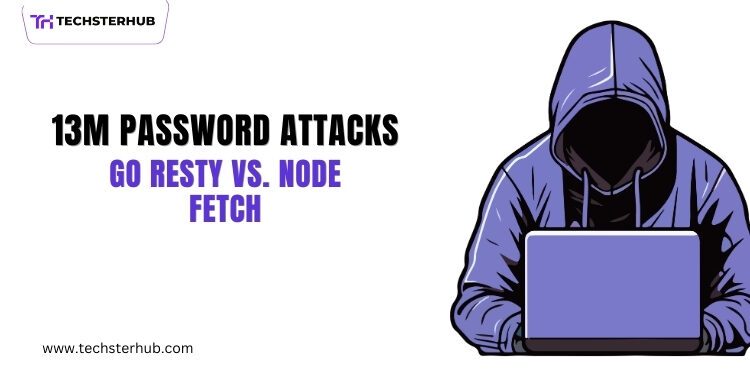One of the primary technique’s cybercriminals employ to illegally access accounts is password spraying which remains a prevalent threat in our digital era. A substantial cyberattack that used Go Resty and Node Fetch to perform over 13 million password spraying attempts was detected by cybersecurity researchers recently. This article covers password spraying fundamentals and demonstrates how Go Resty and Node Fetch enable these attacks while offering protection strategies against such threats.
What is Password Spraying?
Before we can grasp the recent cyberattacks importance, we must first understand what password spraying entails. Password spraying involves cybercriminals guessing multiple passwords across numerous accounts by testing common passwords against different accounts instead of making multiple guesses for individual accounts.
Hackers attempt weak passwords like “123456” or “password123” on multiple accounts aiming to find at least one account with such unsecure passwords. The effectiveness of password spraying stems from the widespread use of simple, predictable passwords. Unlike traditional brute-force attacks which test numerous passwords against a single account, password spraying attacks distribute a few common passwords across numerous accounts.
Go Resty and Node Fetch: The Tools Behind the Attack
The cyberattack that affected many systems involved cybercriminals deploying Go Resty and Node Fetch for their password spraying operations. These tools serve as popular instruments for software developers and automation tasks that require sending internet requests.
What is Go Resty?
Go Resty serves as a widely-used HTTP client designed specifically for the Go programming language. Go Resty enables developers to create HTTP requests (the digital messages computers send to websites and servers) and collect responses. Cybercriminals can employ Go Resty for automating large-scale requests to websites and online services to facilitate password spraying attacks.
The speed and efficiency of Go Resty make it a preferred tool for cybercriminals who use it to send massive numbers of requests quickly. Developers use this tool for legitimate purposes but cybercriminals redirect its functionality toward malicious activities like password spraying.
What is Node Fetch?
Node Fetch works as an HTTP request tool that operates specifically within the Node.js programming environment. Node Fetch serves as an efficient tool for cybercriminals because it allows them to automate requests to online services for launching widespread attacks.
Node Fetch provides lightweight functionality that enables attackers to script and automate password spraying attacks with ease. Cybercriminals select this tool because its straightforward operation enables quick and efficient attacks.
13 Million Password Spraying Attempts
Cybercriminals recently employed Go Resty and Node Fetch to execute over 13 million password spraying attempts in their attack. Cybercriminals focused their efforts on various online platforms to discover accounts protected by common or insecure passwords. These tools enabled cybercriminals to automate millions of logins attempts to gain access to various websites and applications.
The massive scale of this attack becomes evident through the 13 million attempts made during the cyberattack. This incident demonstrates why creating strong and distinct passwords for your online accounts is essential.
Why is This Attack Dangerous?
Password spraying attacks which utilize tools like Go Resty and Node Fetch have potential to cause significant damage. Here’s why:
- Successful password guessing by a hacker provides them access to sensitive information such as personal emails or social media profiles which can result in identity theft and privacy violations.
- Hackers who gain access to an account can modify its password settings to lock out the actual user then they will use it to perform harmful activities like sending spam or distributing malware to other users.
- Cybercriminals perform credential stuffing by using the same password from one hacked account to breach multiple other websites. After password spraying succeeds attackers employ credential stuffing as a frequent method to compromise additional accounts.
- Sometimes successful cyber-attacks result in data breaches that reveal sensitive information about companies and customers.
How to Protect Yourself from Password Spraying Attacks
Password spraying attacks such as the one that impacted Go Resty and Node Fetch can be intimidating but you can protect yourself by following specific protective steps.
- Strong passwords protect you best when they are hard for hackers to guess so avoid common passwords like “123456” or “password” and use a combination of upper and lowercase letters, numbers and special characters.
- Multi-factor authentication provides additional security for your accounts because hackers who guess your password won’t gain access without the second authentication factor like a phone’s code or an authentication app.
- Multiple websites should not share the same password since account compromise in one place puts all your accounts in danger.
- Stay vigilant about your online account activities to spot any odd behavior and report suspicious account login changes which might suggest unauthorized access.
- Setting login attempt limits from individual IP addresses is an effective measure for websites to defend against password spraying attacks because it prevents hackers from trying millions of passwords without facing restrictions.
- Frequently updating your software systems along with browsers and security utilities helps defend against known software vulnerabilities that cybercriminals exploit.
Conclusion
Through the adaptation of new techniques for password spraying attacks cybercriminals continue to advance their methods while tools like Go Resty and Node Fetch enable them to automate these attacks across vast networks. The detection of a password spraying attempt against 13 million targets underscores the critical need for robust cybersecurity measures.
The implementation of unique strong passwords together with additional security measures like multi-factor authentication and monitoring account activities will help minimize your vulnerability to password spraying attacks. Organizations and websites must upgrade their security protocols to defend their users against these types of attacks.
As cybercrime increases it becomes essential for everyone to take active measures to protect their personal information online. Protecting our digital lives requires us all to follow essential safety measures against these expanding threats.











